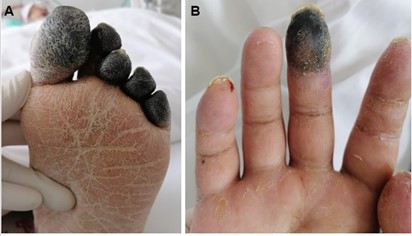Annals of Medical & Surgical Case Reports
(ISSN: 2652-4414)
Asymmetrical Peripheral Gangrene in Severe Patients with COVID-19
Ming Zhan, Wen-Tian Li, Wei Liu*
Institute of Digestive Disease, China Three Gorges University, Yichang, China
Department of Gastroenterology, Yichang Central People’s Hospital, Yichang, China
*Corresponding Author: Wei Liu, Institute of Digestive Disease, China Three Gorges University, 8 Daxue Road, Yichang 443000, China
Citation: Zhan M, Li WT, Liu W (2020) Asymmetrical Peripheral Gangrene in Severe Patients with COVID-19. Ann Med & Surg Case Rep: AMSCR-100078
Received date: 12 December 2020; Accepted date: 23 December 2020; Published date: 29 December 2020
A 51-year-old man presented to the emergency department with a 13-day history of fever, cough, and difficulty breathing the day after his son returning from a trip to Wuhan (Hubei, China), the centre of an out-break of pneumonia of unknown cause at that time. He had a 30-year history of cigarette smoking with 20 cigarettes a day, and he has no history of respiratory disease. His temperature was 39.2°C, the pulse 113 beats per minute, and the blood pressure 117/76 mmHg. Laboratory studies showed a lymphocyte count of 200 per cubic millimeter (reference range, 800 to 3000). Chest CT scan showed bilateral ground-glass opacity in both lower lobes. Then, he and his family were confirmed to be infected by the severe acute respiratory syndrome corona virus 2 (SARS-CoV-2) by reverse transcriptase polymerase chain reaction (RT-PCR) assay due to common respiratory symptoms. A diagnosis of severe Corona virus disease 2019 (COVID-19) pneumonia was made. Treatment can be extremely challenging without particularly effective drugs. In this critically ill COVID-19 patient, nasotracheal intubation and high-flow oxygen therapy were given. And 2 weeks later, gangrenous changes progressed with left toes and right middle fingertip frankly turning into asymmetrical peripheral gangrene (APG) (Figure A,B). A color doppler study of peripheral arterial and venous system revealed no evidence of thrombus or large vessel obstruction. APG is a poorly documented but rare clinical syndrome characterized by asymmetrical distal ischemic damage resulting in gangrene of multiple sites in the absence of large vessel obstruction. It has been reported that peripheral gangrene is associated with virus infection [1,2]. In this rare case, complex interactions between immune disorder induced cellular inflammatory mediators released and coagulation abnormality, and platelet hyper reactivity caused by SARS-CoV-2 during viral replication could be the contributing factors for APG causation [3-5]. Further studies are needed to explore other factors related to it. Finally, the patient died several days later.
Acknowledgements
Funding: This work was supported by National Natural Science Foundation of China (31600134).
Conflicts of Interest: The authors have no conflicts of interest to declare.
Ethical Statement: The authors are accountable for all aspects of the work in ensuring that questions related to the accuracy or integrity of any part of the work are appropriately investigated and resolved. Written informed consent was obtained from the patient for publication of this “Image in clinical medicine”.

Figure 1: Asymmetrical peripheral gangrene in critically ill patients with COVID-19. (A) Dry gangrene of left toes with clear demarcation; (B) Dry gangrene of right middle fingertip with clear demarcation
Citation: Zhan M, Li WT, Liu W (2020) Asymmetrical Peripheral Gangrene in Severe Patients with COVID-19. Ann Med & Surg Case Rep: AMSCR-100078